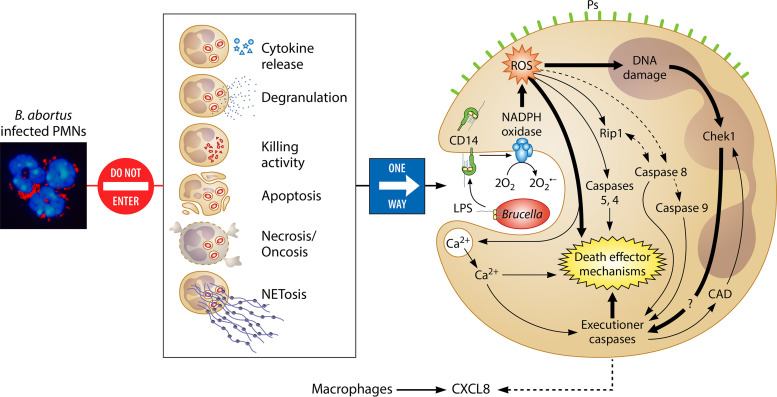FIG 7.
Brucella organisms do not activate PMNs but induce the premature cell death of these leukocytes. PMNs (nuclei in blue) heavily infected with B. abortus (in red) do not display significant phenotypic changes characteristic of degranulation, apoptosis, necrosis/oncosis, or NETosis and do not display significant bactericidal activities or release proinflammatory cytokines. However, through the release of nonendotoxic Br-LPS inside infected PMNs, B. abortus organisms promote the premature cell death of these leukocytes. After fusion with cell membranes, Br-LPS interacts with CD14 lipoprotein, progressively recruiting the action of NADPH oxidase and promoting the slow generation of controlled amounts of ROS mediators, which induce oxidative fragmentation of nuclear DNA and the recruitment of Chek1 protein, which is mainly responsible for coordinating the DNA damage after the activation of caspase-activated DNases (CAD). At the same time, some of the ROS effectors may induce recruitment of the RIP1 kinase/FADD cell death routes and caspase 8 and promote the release of Ca2+ to the cytosol. These mediators also recruit cell death executioner caspases and, together with ROS mediators, trigger additional death effector mechanisms (e.g., activation of calpains and cathepsins). Finally, the initiator caspase 9 of the intrinsic cell death pathway is activated downstream by caspase 8, contributing to the premature PMN cell death mechanism. In this process, the infected PMNs release chemokine CXCL8 to attract mononuclear phagocytic cells and expose “eat me” signals (e.g., phosphatidylserine [Ps]) on the surface to promote their phagocytosis. Since Br-LPS does not interact with TLR4 on PMNs, then these cells do not become activated through this pathway. (Adapted in part from supplemental material for reference 139, published under the terms of the Creative Commons Attribution license [http://creativecommons.org/licenses/by/2.0]. The photo [far left] is reproduced from reference 205.)

